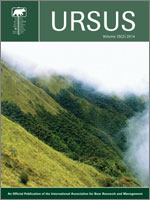Managers of American black bears (Ursus americanus) must maintain populations to ensure viability and opportunities for sport harvest, and minimize human–bear conflict (HBC). Harvest is a cost-effective management tool in most jurisdictions, and intuitively it seems that with fewer bears, there should be fewer conflicts. Therefore, managers may attempt to achieve both objectives by manipulating the harvest. Further, because data describing harvest and HBC are frequently collected, managers sometimes infer changes in population status from trends in harvest and HBC. However, evidence that larger harvests reduce HBC is lacking, and changes in harvest metrics and the frequency of HBC may be independent of bear density. Understanding relationships among food availability, hunter effort, harvest, and HBC could help managers avoid making invalid inferences about population status from data describing harvest and HBC, and evaluate whether management actions are having intended results. We investigated relationships among food availability, HBC, and harvest at landscape scales in Ontario, Canada, 2004–2011. We hypothesized that HBC and harvest would be negatively correlated with food availability; that HBC would be negatively correlated with prior harvest; and that harvest would be positively correlated with number of hunters. We used Spearman rank correlation to test hypotheses. Human–bear conflict was negatively correlated with food availability across Ontario, and in the 2 administrative regions where food availability varied synchronously. Total harvest and the proportion of females in the harvest were negatively correlated with food availability across Ontario and in one region. Human–bear conflict was not correlated with prior harvests, providing no evidence that larger harvests reduced subsequent HBC. Given the variation in natural foods, harvest is unlikely to prevent elevated levels of HBC in years of food shortage unless it maintains bears at low densities—an objective that might conflict with maintaining viable populations and providing opportunities for sport harvest.
How to translate text using browser tools
1 October 2014
Relationships among food availability, harvest, and human–bear conflict at landscape scales in Ontario, Canada
Martyn E. Obbard,
Eric J. Howe,
Linda L. Wall,
Brad Allison,
Ron Black,
Peter Davis,
Linda Dix-Gibson,
Michael Gatt,
Michael N. Hall
ACCESS THE FULL ARTICLE

Ursus
Vol. 25 • No. 2
October 2014
Vol. 25 • No. 2
October 2014
American black bear
food availability
harvest
human–bear conflict
Ontario
Ursus americanus




